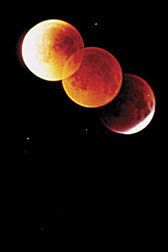CLICK "WATCH THE ECLIPSE LIVE ON THE INTERNET": TO WATCH A TIME LAPSE OF LUNAR ECLIPSE!!
Five and a half hour lunar eclipse compressed into one minute
 |
Total Lunar Eclipse!
|
Key Total Lunar Eclipse Moments
| 7:08 p.m. | Moon rises along eastern horizon. |
| 1:15 a.m. | Penumbral eclipse begins. (Observatory LIVE webcast of eclipse starts.) |
| 2:14 a.m. | Umbral first contact (First portion of the Moon is visibly eclipsed.) |
| 3:25 a.m. | Totality begins. (Moon is completely eclipsed.) |
| 3:54 a.m. | Greatest eclipse |
| 4:24 a.m. | Totality ends. (Moon emerges from shadow.) |
| 5:34 a.m. | Umbral eclipse ends. |
| 5:45 a.m. | Observatory LIVE webcast of eclipse ends. |
Total Lunar Eclipse October 8, 2014
Science Event ·
Date
Wed Oct, 8 2014 3:15 AM CDT — Wed Oct, 8 2014 7:45 AM CDT
About
What Is a Total Lunar Eclipse? A total lunar eclipse occurs when the Moon passes into the shadow cast by the Earth. The round disk of the full Moon slowly moves into the dark shadow, and the bright Moon grows dim. The Moon, however, does not become completely dark. Instead, it glows with a faint copper or red color, a result of sunlight being filtered and bent through the Earth's atmosphere (like a sunset). How to Watch the Eclipse. If skies are clear, the lunar eclipse will be visible throughout southern Californa and can be seen with the unaided eye. All you need to do is look up! See the timeline below. Telescopes or binoculars will enhance the view.
Links
- Total Lunar Eclipse! October 8, 2014http://www.griffithobservatory.org/exhibits/special/Lunar_Eclipse_October_2014.html

OBSERVATORY NEWS
 OBSERVATORY BROADCASTS LUNAR ECLIPSE!
OBSERVATORY BROADCASTS LUNAR ECLIPSE!On October 8, 2014, Griffith Observatory broadcast the entire total lunar eclipse. Relive the amazing experience on our Griffith TV page, including a one-minute time-lapse film of the whole event!
AN INTERVIEW WITH THE OBSERVATORY DIRECTOR
Dr. Krupp was interviewed recently by the online science magazine Nautilus about how people use astronomy. The interview is broken up into 10 "questions" which are each played one at a time.
OBSERVATORY NEWS AND SPECIAL NOTICE ARCHIVE
Dr. Krupp was interviewed recently by the online science magazine Nautilus about how people use astronomy. The interview is broken up into 10 "questions" which are each played one at a time.
OBSERVATORY NEWS AND SPECIAL NOTICE ARCHIVE
CLICK "WATCH THE ECLIPSE LIVE ON THE INTERNET": TO WATCH A TIME LAPSE OF
 |
Total Lunar Eclipse!
|
What Is a Total Lunar Eclipse?
A total lunar eclipse occure when the Moon passes into the shadow cast by the Earth. The round disk of the full Moon slowly moves into the dark shadow, and the bright Moon grows dim. The Moon, however, does not become completely dark. Instead, it glows with a faint copper or red color, a result of sunlight being filtered and bent through the Earth's atmosphere (like a sunset).
How to Watch the Eclipse
If skies are clear, the lunar eclipse will be visible throughout southern Californa and can be seen with the unaided eye. All you need to do is look up! See the timeline below. Telescopes or binoculars will enhance the view. You can also watch via the live webcast at http://new.livestream.com/GriffithObservatoryTV.
Bad Weather Plan
If the night is cloudy, there will not be a webcast.
Key Total Lunar Eclipse Moments
| 7:08 p.m. | Moon rises along eastern horizon. |
| 1:15 a.m. | Penumbral eclipse begins. (Observatory LIVE webcast of eclipse starts.) |
| 2:14 a.m. | Umbral first contact (First portion of the Moon is visibly eclipsed.) |
| 3:25 a.m. | Totality begins. (Moon is completely eclipsed.) |
| 3:54 a.m. | Greatest eclipse |
| 4:24 a.m. | Totality ends. (Moon emerges from shadow.) |
| 5:34 a.m. | Umbral eclipse ends. |
| 5:45 a.m. | Observatory LIVE webcast of eclipse ends. |


No comments:
Post a Comment